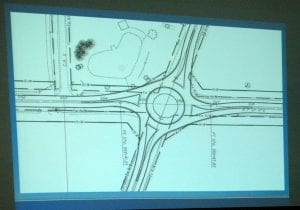 If CR 24 in Fulton County’s German Township becomes the new route for SR 66, it will include roundabouts and a bypass to keep traffic flowing and spare a grain elevator. Those are the recommendations presented to the Board of Fulton County Commissioners recently. The board listened to a presentation of the findings of a feasibility study funded by the state.
If CR 24 in Fulton County’s German Township becomes the new route for SR 66, it will include roundabouts and a bypass to keep traffic flowing and spare a grain elevator. Those are the recommendations presented to the Board of Fulton County Commissioners recently. The board listened to a presentation of the findings of a feasibility study funded by the state.
The recommendations will be reviewed by the village of Archbold which, as the local political authority; will decide if the project is a go. The idea of moving SR66 from downtown Archbold to the county road has been talked about since the 1960s.
The feasibility study was commissioned for $1.3 million to determine which option of shifting traffic, or not, was the best. While the no change option was listed, and involves no expense, it will do nothing to reduce the traffic totals (including semi-tractor trailers) well into the future.
The whole reason for the study and the shifting of traffic routes is to reduce truck traffic, congestion, traffic crashes in Archbold along with serving the current and future travel demands and provide a more direct route between:
– Ohio Turnpike and U.S. 20A to the north
– U.S. 6 and U.S. 24 to the south
The recommended options are not cheap, but are considered the best in dealing with the proposal. But further study and public comments are in the offering before things get serious.
The presentation by Robert Seaman, Archbold village engineer and Andrew Langenderfer of Tetra Tech, covered the project from the first concept from the 1960s through the recommendations of 2017. The pair took turns talking about certain aspects of the plan.
The main option is turn CR 24 into the new SR66 to remove truck traffic from the village. The project would use roundabouts and new bridges to handle the increased traffic volume and reducing the threat for crashes and fatalities.
A grade separation study calls for a bypass overpass with a three span pre-stressed concrete beam bridge by relocating the roadway alignment to the west of the Gerald Grain Center. The abutments would consist of spill-through type integral pile supported abutments. Both roadway approaches use fill slopes – no retaining walls are required. This option is less expensive and that is can be constructed away from the main road causing fewer disruptions to industrial and residential properties.
Roundabouts are seen as the safest option for intersections as opposed to traditional signalized options (stop lights, signs).
In the latest statistics, 2,300 people died in crashes at one of 300,000 signaled intersections nationwide. Around 700 died in crashes involving running a light.
Converting from a two-way stop to a roundabout causes a:
– 35 percent reduction in total crashes;
– 76 percent reduction in injury crashes;
– 89 percent reduction in fatalities.
Roundabouts are also safer for pedestrians, especially near schools the engineers said.
The feasibility study has gone through about 60 percent of the $1.3 million set aside for the preliminary engineering.
The study has entered another comment period and Fulton County Engineer Frank Onweller said the commissioners can make a formal comment on the proposals. Officials will review the comments before making a formal recommendation to the central office, he said.
The next step in the Preliminary Engineering (PE) process will be ODOT’s review of the final Feasibility Study Report, consideration of the no-build or build option(s), and Purpose and Need document. ODOT will use the Feasibility Study and Purpose and Need to help evaluate the proposed project’s transportation needs, the positive and negative impacts caused by the proposed project and the public/agency concerns expressed on this proposed project.
Should the Village of Archbold wish to advance the project, it will be at ODOT’s discretion to proceed with completion of the PE steps for the proposed project if in ODOT’s opinion, the transportation purpose and need is met, the benefits overcome the impacts, and the benefits to the general public overcome the public’s concerns to the proposed project.
Among the next steps will be
•Build or No-Build
•If Build, Then:
*For Corridor: Alternative 1 or Alternative 2
–Or Variation of Either Alternative
*For Railroad: Grade Crossing or Separation
–If Grade Separation, Then:
–Alternative A, B, C or D
•Develop Stage 1, Stage 2, and Preliminary Right of Way plans
•Develop preliminary grade separation plans, if desired by Archbold
•Public meeting following completion of Stage 1 and Preliminary Right of Way Plans
•Secure Final Design, Right-of-Way and Construction Funding
